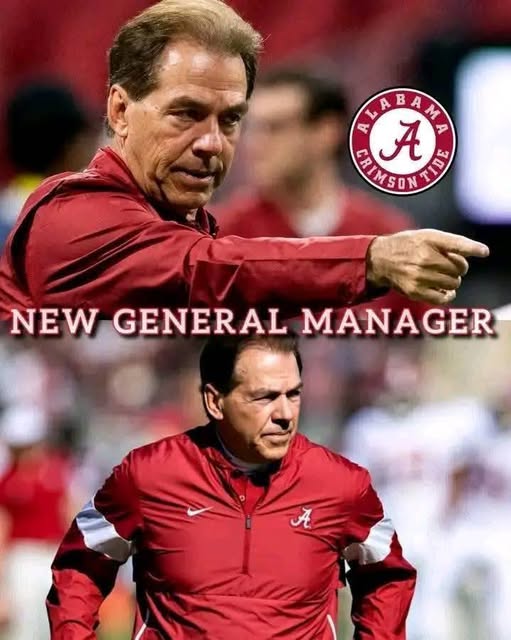
In a groundbreaking development that has sent shockwaves through the college football world, legendary coach Nick Saban is making headlines yet again—this time, not as a head coach, but in a newly minted role that could redefine the structure of leadership in college athletics. The University of Alabama has announced that Saban has signed a lucrative $105 million extension to remain with the Crimson Tide as the program’s General Manager, a title that comes with sweeping authority over football operations, personnel decisions, and long-term strategic planning.
This seismic shift not only ensures the continuity of the Alabama dynasty but also underscores the rapidly evolving nature of college athletic administration in the Name, Image, and Likeness (NIL) and transfer portal era. Saban’s new role, supported by unwavering institutional backing, represents a bold new chapter for Alabama football—and potentially a model for programs nationwide.
From Head Coach to General Manager: A Natural Evolution
Nick Saban, now 73 years old, retired from head coaching in early 2024 after a legendary career that saw him win seven national championships and revolutionize the Southeastern Conference (SEC) into the preeminent league in college football. While many speculated he would fully retire from football, insiders knew that Saban’s passion for building elite programs ran deeper than the sidelines.
Under his new title as General Manager—a role commonly associated with the NFL—Saban will oversee Alabama’s recruiting infrastructure, NIL strategy, transfer portal decisions, coaching hires, and analytics-based football operations. He will serve as a mentor to new head coach Kalen DeBoer, ensuring philosophical continuity while allowing the day-to-day coaching responsibilities to shift to the next generation.
Saban’s unique ability to identify talent, manage massive football ecosystems, and enforce high standards of discipline and performance made this transition not just plausible but ideal. Rather than becoming a figurehead or stepping back into a passive consultant role, the General Manager position empowers Saban with real authority to shape the Crimson Tide’s future.
The Financial Breakdown: $105 Million Over 10 Years
The terms of the deal are unprecedented in the college football world. Saban’s contract extension is reportedly worth $105 million over 10 years, equating to an annual compensation package of $10.5 million—matching or exceeding that of the highest-paid college coaches and many NFL executives.
The contract includes performance incentives tied to College Football Playoff appearances, national championships, and recruiting class rankings. Notably, the deal also secures robust funding for Alabama’s off-field infrastructure, including analytics, sports psychology, and a major expansion of the school’s NIL operation, “Tide Legacy.”
This bold financial commitment by the University of Alabama not only reinforces the administration’s faith in Saban’s vision but also signals a long-term institutional investment in maintaining Alabama’s status at the apex of college football.
Why This Move Matters: The GM Model Comes to College Football
The elevation of Nick Saban to a General Manager position is more than just a ceremonial gesture—it’s a reimagining of leadership within college football programs. In an era where NIL valuations, brand management, donor relations, and transfer portal negotiations often outweigh traditional recruiting visits, programs are beginning to recognize the need for top-down strategic direction beyond coaching Xs and Os.
By moving Saban into this role, Alabama becomes the first program in the nation to formally adopt a hybrid model of leadership that combines collegiate tradition with professional sports management. Just as NFL general managers handle roster composition, salary caps, and draft strategy, Saban will now be the architect of Alabama football’s competitive blueprint.
It’s not hard to imagine other powerhouse programs following suit. At Georgia, Kirby Smart may someday step into a similar role. At Michigan, the post-Harbaugh era could eventually see an executive transition for Jim Harbaugh should he return from the NFL. What Alabama has done is trailblazing—and potentially transformative.
The Kalen DeBoer–Nick Saban Partnership
Central to this transition is Alabama’s current head coach, Kalen DeBoer. After leading Washington to a College Football Playoff appearance in 2023, DeBoer was chosen as Saban’s successor and took over a program loaded with expectation and pressure. While DeBoer has his own modern, dynamic offensive approach, the partnership with Saban provides a stabilizing force.
In his GM capacity, Saban will act as both strategist and advisor. Sources inside the program say that DeBoer welcomed the arrangement, viewing it as a unique opportunity to work alongside the greatest mind in college football history without having to navigate the politics of a divided administration or donor base.
This partnership also ensures that Alabama’s identity—marked by defensive toughness, elite recruiting, and relentless preparation—remains intact.
Institutional Support and Strategic Investment
Perhaps the most significant aspect of this transition is the institutional alignment behind it. University President Dr. Stuart Bell, Athletic Director Greg Byrne, and Alabama’s Board of Trustees unanimously supported Saban’s new role, a rare show of unity in the high-stakes world of college athletics.
Alabama has also pledged over $40 million in additional support for facilities, NIL operations, and recruiting resources. Plans are already underway to expand the football complex, adding a state-of-the-art NIL command center, media content production suites, and player brand development labs.
According to Byrne, “Nick Saban has always been more than a coach. He’s a visionary. We are proud to continue this journey with him in a capacity that will shape not just Alabama football but the future of college athletics.”
Saban’s New Priorities: NIL, Portal, and Personnel
As General Manager, Saban’s top priorities are clear:
- NIL Optimization: Alabama’s “Tide Legacy” collective will now be supervised under Saban’s broader strategic guidance. He aims to use NIL as both a recruitment tool and a long-term athlete development platform. By aligning donors, brands, and athletes, Saban wants to ensure that Alabama players maximize both their on-field and off-field potential.
- Transfer Portal Strategy: With player movement at an all-time high, Saban is assembling a team of analysts, scouts, and former coaches to evaluate portal talent in real time. The goal: make Alabama the premier destination for elite transfers seeking championships and NFL exposure.
- Staffing Excellence: Saban will continue to have major influence over assistant coaching hires, strength and conditioning staff, and sports science development. His fingerprints will remain on every facet of the program.
Reaction Across the College Football Landscape
The announcement triggered widespread commentary from coaches, analysts, and fans across the nation. SEC rival Lane Kiffin called the move “brilliant and inevitable,” while ESPN analyst Kirk Herbstreit described it as “a moment of transformation for the sport.”
At Ohio State, Ryan Day remarked, “No one understands how to build a program better than Coach Saban. If you thought he was done influencing the game, think again.”
Even NFL circles took notice. Longtime New England Patriots executive Scott Pioli commented, “This is as close to an NFL structure as college football has ever seen. Nick Saban’s ability to evolve sets the gold standard for the profession.”
The Future of Alabama Football—and the Sport
With Nick Saban at the helm in a new capacity, Alabama isn’t just preparing for another decade of dominance—it’s pioneering a new era. The General Manager model could offer a lifeline to other programs struggling with rapid change. In Saban’s hands, it becomes both a legacy-defining role and a blueprint for 21st-century college football leadership.
For Saban himself, the position is poetic. He has often spoken of his desire to influence young lives and build elite organizations—not just win games. In stepping away from the sidelines but not the sport, he’s doing exactly that.
This move may ultimately prove to be his most important contribution yet.
Final Thoughts: Legacy Reinvented
Nick Saban’s transition to General Manager is not retirement; it’s reinvention. Just as he reshaped LSU, the SEC, and Alabama football, he now turns his eye to reshaping the very fabric of college athletics. With a $105 million deal and total institutional buy-in, the Crimson Tide aren’t just keeping their greatest leader—they’re giving him the keys to the future.





